Curiosities
How Seriously Should We Take This Bored-Ape Conspiracy Theory? + More Questions About the Week’s Art News
Plus, is this the strangest art sponcon to date?
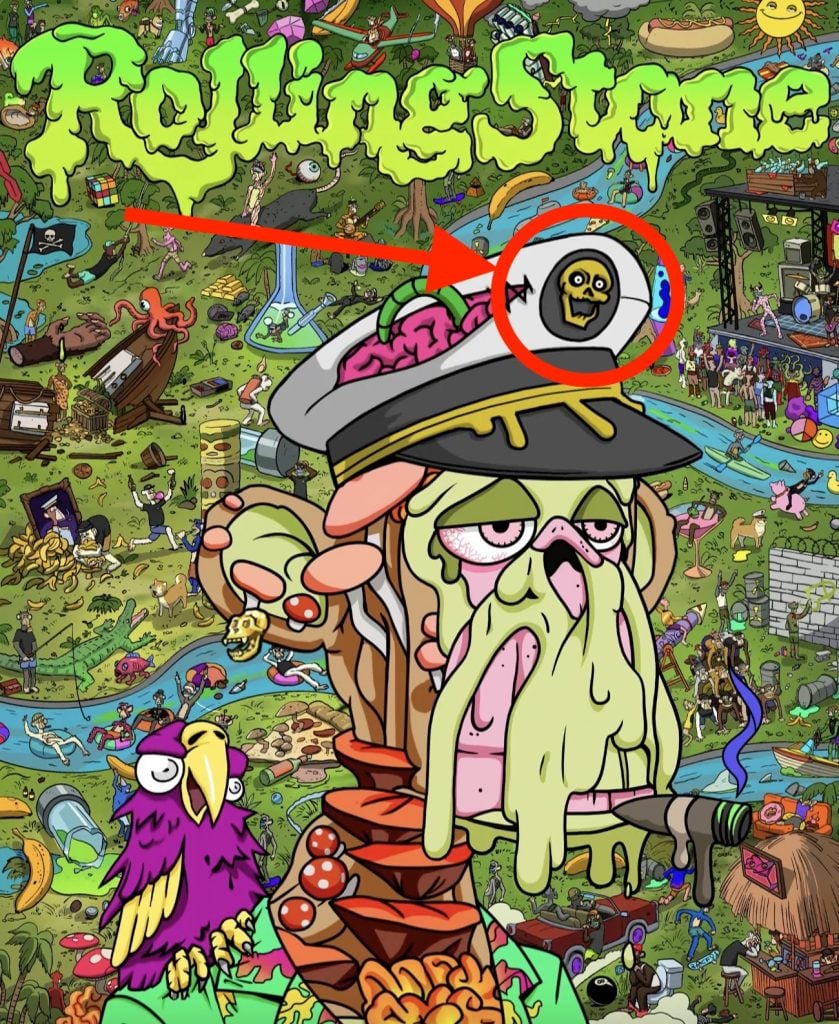
Plus, is this the strangest art sponcon to date?

by
Ben Davis

Curiosities is a column where I comment on the art news of the week, sometimes about stories that were too small or strange to make the cut, sometimes just giving my thoughts on the highs and lows.
Below, some questions posed by the events of the last week…
I started this column last year because it felt like culture was melting down, and sometimes the best thing to do was laugh at it. Fortunately, 2022 is starting off in a much calmer, more reasonable groove… no, just kidding, people’s brains are still running out of their nose and ears.
Mere days into the new year, the Bored Ape Yacht Club—the famed NFT collection of “edgy, haphazardly constructed art pieces” (in Rolling Stone’s admiring words)—has been rocked (very slightly) by accusations that it is actually coded neo-Nazi propaganda designed to… make lots of money because people don’t know it is neo-Nazi propaganda… and then… I am already confused.
The face of the BAYC-Is-Nazi-Propaganda movement is artist Ryder Ripps, best known these days for the NFT he put out with his rapper ex Azealia Banks last year, I Fucked Ryder Ripps, featuring audio of the two in the sack. And, more recently, for selling NFTs incorporating the sex pictures from Hunter Biden’s stolen laptop.
The controversy over coded alt-right messages in BAYC began in a January 3 Twitter Spaces chat called “The BAYC Racism Debate,” but Ripps has taken to the cause, culminating in an interview with KnowYourMeme last week where he made the case for the prosecution.
The big pieces of evidence are:
—“Yuga Labs,” the name of the company that makes the Apes, is alleged to refer to the “Kali Yuga,” an esoteric idea of a recurring age of demonic struggle that leads to cultural rebirth. “Surf the Kali Yuga” is some kind of modern alt-right meme.
Proof that “Bored Ape Yacht Club” is inspired by the concept is found in the way its name echoes that of the (small and obscure) “Kali Yuga Surfing Club,” an alt-right Telegram chat group (“surfing club” in the latter instance also refers to any online forum where people post web content to surf).
By coincidence, Yuga Labs posted a thread on January 3 where they explained their origins, saying that actually their name was inspired by a villain in the 2013 video game Legend of Zelda: A Link Between Worlds.
A little a bit about us to start off the new year and what's coming. ?
1. What's the inspiration behind the name Yuga Labs?
We're nerds, and Yuga is the name of a villain in Zelda whose ability is that he can turn himself and others into 2D art. Made sense for an NFT company.
— Yuga Labs (@yugalabs) January 3, 2022
—The BAYC ape skull logo looks like an elite Nazi skull-and-crossbones patch, minus the crossbones.
What’s more, both have 18 teeth, with 18 being “alphanumeric code” for “Adolf Hitler,” according to the Anti-Defamation League hate symbol database (though the ADL links it to one British hate group in particular).
oh one more thing about these logos, they have the exact same amount of teeth in the scull, i have yet to find another ape skull drawing with 18 teeth. pic.twitter.com/hbIsWnGvX3
— (((RYDER RIPPS))) (@ryder_ripps) January 7, 2022
“It’s even hard to find human scull drawings with 18 teeth,” Ripps writes. (Actually, it’s pretty easy—it happens a lot when you show skulls in profile, as is the case here or with these two or this one or also this one.)
—One of the still-anonymous quartet of founders’ pseudonyms is “Gargamel.” He explained to Rolling Stone that it was “a name I ridiculously gave myself based off the fact that my fiancée had never seen The Smurfs when we were launching this.”
This seems a reasonable explanation—though I hate to see his girlfriend’s shameful secret exposed like this.
Ripps, however, has an alternative reading: the Smurfs villain has long been thought to be an anti-Semitic caricature.
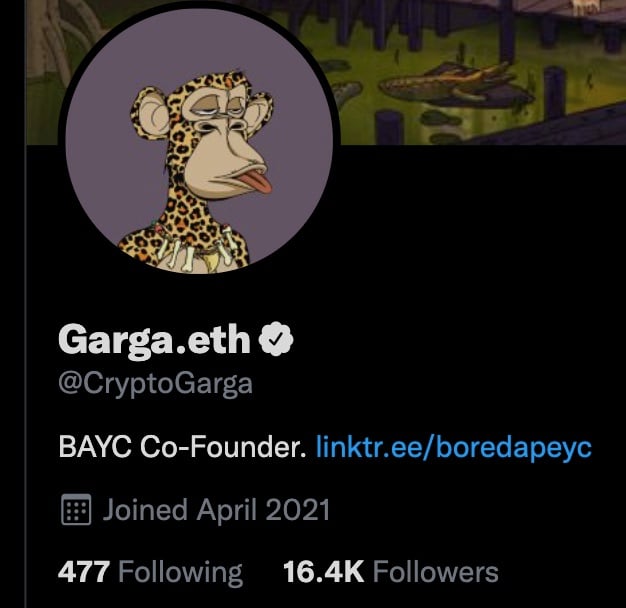
Screenshot of the Twitter profile of BAYC founder Gargamel.
—Another BAYC founder is “Gordon Goner,” who told Rolling Stone he chose the name because it sounded like he was in a punk band.
Noting that the BAYC has hosted anagram puzzles on its site, Ripps has done the hard work to unveil the fact that Gordon Goner actually hides the words… “Drongo Negro.” I’ll pause to let that sink in and also for you to curiously google what “drongo” means (it’s obscure-to-me Aussie slang meaning “dumb”).
It can’t be a coincidence, Ripps postulates, because the name “has no meaning outside” of the potentially coded racist phrase. Which is true, unless you count similarly far-out anagrams like the reference to the military’s “Gorgon Drone” or the slacker-pirate alter ego “No Dong Roger.”
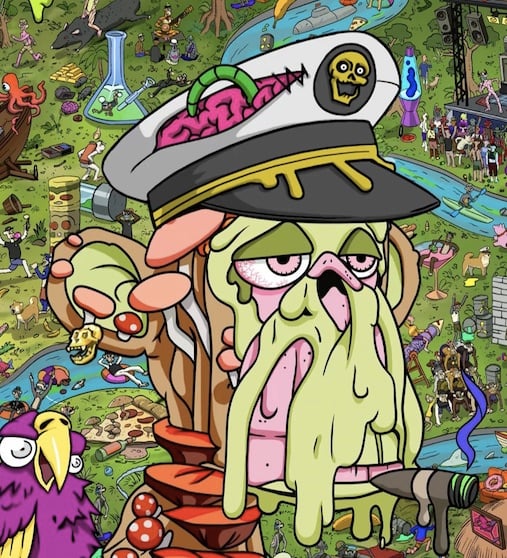
—The Bored Ape on the Rolling Stone cover is wearing what is alleged to be a Nazi admiral’s hat, as proven by the hat’s skull insignia.
Except that the white color clearly just looks like a garden-variety captain’s hat, with a cackling Bored Ape logo in it, suggesting the state of the poor dumb ape’s worm-eaten brain.
—Some of the Apes have Hawaiian shirts, which are a symbol for the far-right Boogaloo movement (and/or the Parrothead movement). Some of the Apes rock military attire of various kinds, like the “Prussian Helmet” or WWII fighter gear or Vietnam War-era military jackets. Some wear togas with laurels, a coded reference to the alt-right hunger for a return to Western greatness.
At the same time, some also wear Russian fur caps sporting the Hammer and Sickle, i.e. the BAYC “Commie Hat” attribute—which is not a symbol particularly loved by the alt-right at all. The opposite.
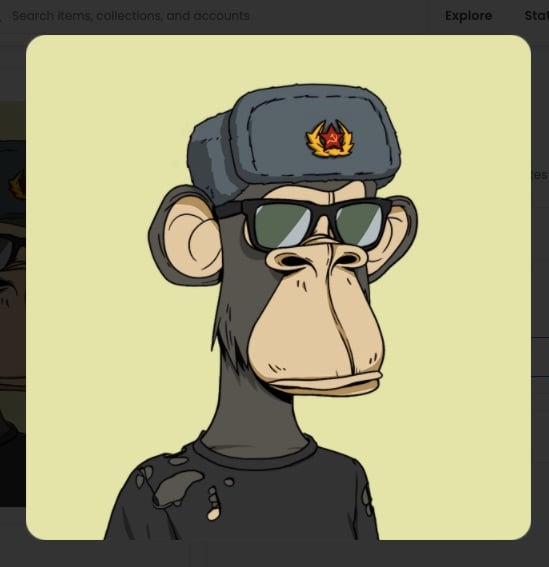
Screenshot of a Bored Ape rocking the “Commie Hat” attribute.
Some also wear rainbow beanies and bunny ears.
—The BAYC project launched on April 30, which is the anniversary of Hitler’s death, Ripps has revealed, hypothesizing that the BAYC founders planted this fact in the New Yorker specifically as a dog whistle.
—What’s more, the BAYC “Prison Jumpsuit” attribute has the number “019807” on its breast, which Ripps helpfully decodes: take out the 0s and it’s 1987—the very year another Nazi, Rudolf Hess, died!
1987 on the prison uniform, same year nazi prison is demolished where Hitler's secretary, Rudolf Hess kills himself in PRISON. another coincidence? need the mathematicians to run the numbers here! what are the odds?! https://t.co/X3odO2kNBN pic.twitter.com/MAGf7cvcC5
— (((RYDER RIPPS))) (@ryder_ripps) January 3, 2022
OK, there is a lot more, but these are the most solid pins in an everything-is-connected corkboard of the BAYC controversy. Slogging through it all makes me feel like a Mutant Ape Serum has been applied to reality. Dig into it if you dare.
The NFT community has definitely taken note, but the publicity hasn’t done Ripps a ton of favors. Foes have dug up, among other things, screenshots from Azealia Banks’s Instagram stories, which seem to blame Ripps’s NFT fever for their breakup.
[Update: In an emailed reply to this article, Ryder Ripps writes: “My personal life has nothing to do with the fact I am offended by BAYC. I have many many text messages that I could share that prove Azealia Banks’ words are slander vindictively published for about 2 minutes on an instagram story before she took it down. People who have published her slander are doing so only as a deflection to the bigger issues at hand. The issue of racist and antisemitic imagery is bigger than me and no matter my personal relationships, I am still entitled to an opinion. What you are publishing would not even make the cut of TMZ, it’s truly garbage… be better, critique art not social media gossip.”]
As for BAYC: Is building an ape avatar collection with randomly assigned “Hip Hop” and “Pimp Coat” attributes liable to generate queasy results, ones possibly read as offensive? It’s arguable, and I take it that’s what a lot of the BAYC-and-racism conversation was prior to this! But the most logical conclusion is still that the founders were trying to make a quick buck off the NFT explosion, like dozens and dozens of other people, but so encased in a certain corner of internet culture where “apes” are synonymous with crypto-mania that they didn’t stop to think about this.
Time will tell if its founders are actually exposed as a secret cabal of sinister alt-right masterminds with a plot to simultaneously sell doofy profile-pic art to celebs and encode secret messages about a race war. If race war is their objective, it would probably be a shock to the celebs like Chris Rock with whom they have officially collaborated! But the BAYC founders aren’t doxxed (that is, public with their identities), so people can think what they want about them.
Still, I can’t believe I need to say this, but calling someone a Nazi is a serious thing. You should have more than just the equivalent of word association if you are going to do it.
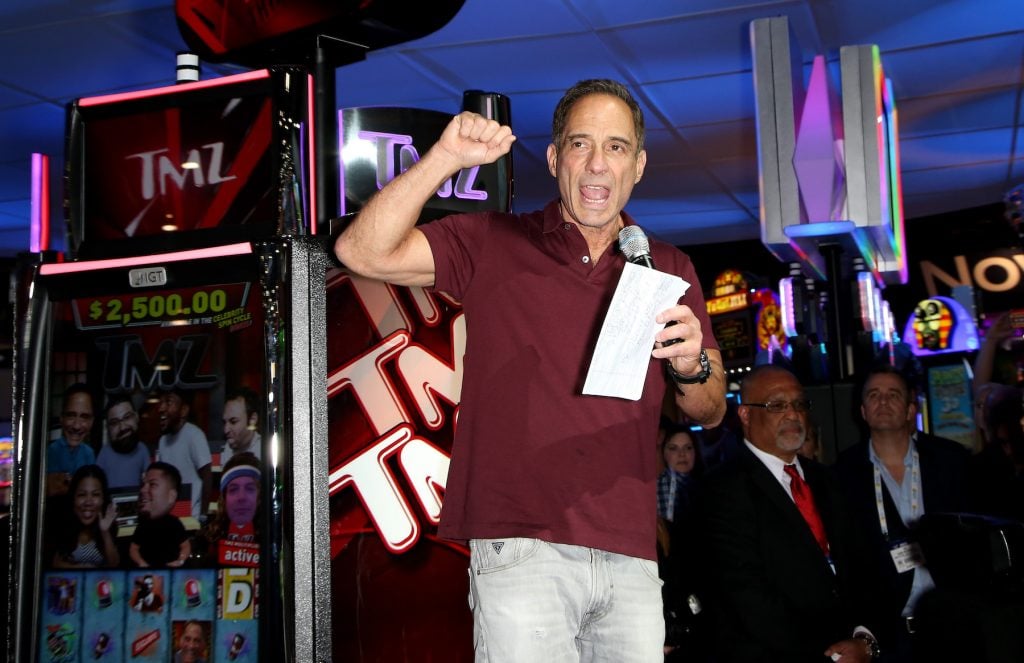
TMZ Executive Producer Harvey Levin unveils IGT’s TMZ Video Slots at the Global Gaming Expo 2015 at the Sands Expo and Convention Center on September 30, 2015 in Las Vegas, Nevada. (Photo courtesy Getty Images.)
If I told you that Masterworks.io, the company hoping to sell the public on the idea of owning tradable shares in blue-chip artworks, did a sponsored content partnership with Boat International, that would make sense. It would also be true!
Less obvious—but maybe more true to Masterworks’s final goal of making day-trading fractional art shares mainstream—is their sponcon team-up with TMZ, the scandal sheet known more for its coverage of the Tiger King saga than for its fine-art coverage.
The head/subhead combo says it all: “This Platform Makes It Easy For Poor Schlubs Like Us To Invest in Fine Art!” and “GET IN ON THE ARTSY ACTION … Here’s a Way to Invest!!!” All those exclamation marks—you know it’s real! What a scoop!!!
I ended last year writing about the Birds Aren’t Real movement, a fake conspiracy theory looking to mock conspiracy theories. And I came back to a nice note from the Connecticut indie band Fast River, who say they found out about it from that column, and have made a song about it (though I was only commenting on a Times piece by Taylor Lorenz, who did what we in the biz call “actual reporting”).
And now the chorus of Fast River’s winsome Birds Aren’t Real is stuck in my head. This is the acoustic version, but I’m told they plan a full band release of the song with a music video featuring their bassist in a giant bird suit in February.
Aside from endorsing very important questions about birds that the song addresses, I’m posting it here to promote my own important message: If you make a song based on something I wrote, I will probably post about it.